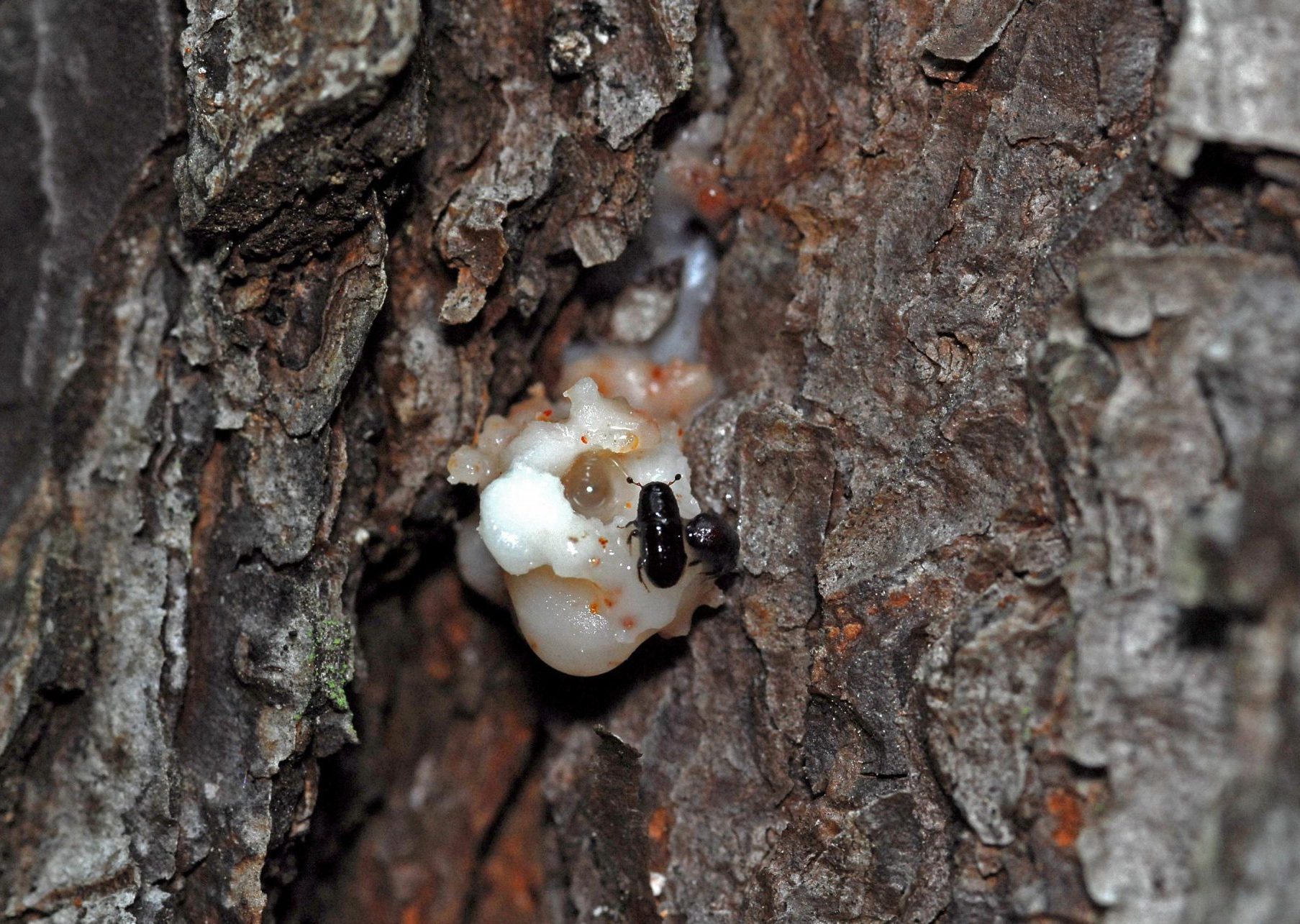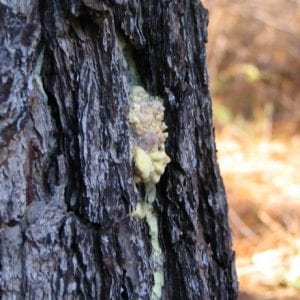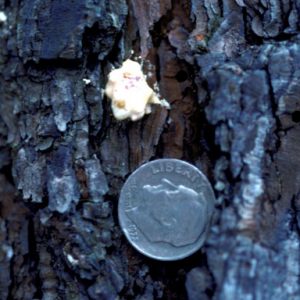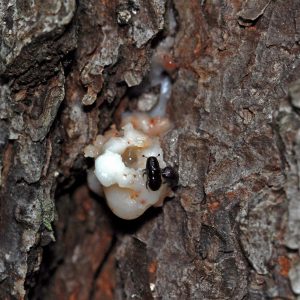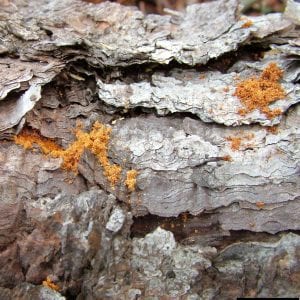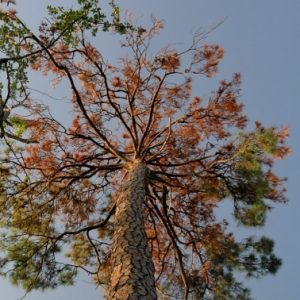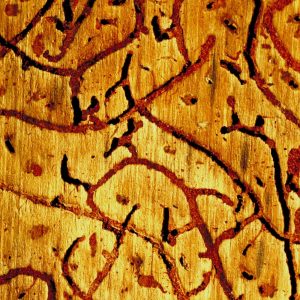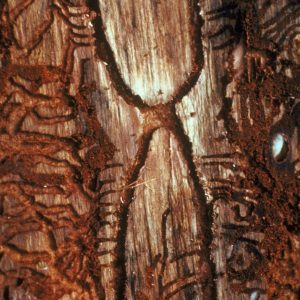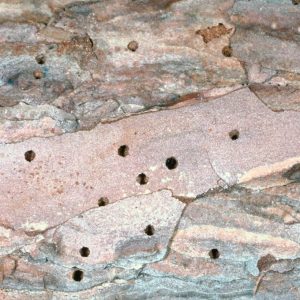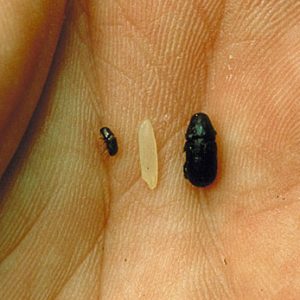Forestry

An overview of the identification of pine bark beetles, causes for infestation in the urban landscape, and recommended integrated pest management techniques. Pine bark beetle (PBB) is a broad term used to describe several species of native Dendroctonus beetles that infest and can kill southern pine trees.
Common PBB in Alabama include the black turpentine beetle Dendroctonus terebrans (BTB), Ips engraver beetle—of which there are three species: small southern pine engraver Ips avulsus, five-spined Ips grandicollis (Eichhoff), and six-spined Ips calligraphus (Germar)— and southern pine beetle Dendroctonus frontalis Zimmermann (SPB).
PBB are typically attracted to stressed pines and can become a major concern in urban forests during droughts, following hurricanes and other strong storms, or as a result of root damage or poor growing conditions. If left unmanaged, beetles can easily spread to healthy pines and potentially devastate large acreages. In the urban forest, the management techniques for controlling PBB are different than those implemented in rural timberlands because of the higher values and removal costs of landscape pines.
When are pine bark beetles most active?
PBB are most active during the months of May through October. When average daily temperatures remain low, as in winter, beetle development slows significantly. Years with warm fall temperatures can see beetle activity reach deep into the fall season. In spring, as daily average temperatures rise into the mid-80s, beetle life cycles speed up, and their numbers increase. PBB activity increases about the time pine pollen is flying and dogwoods begin to flower.
What attracts pine bark beetles?
PBB are attracted to stressed pines in declining health. The following are common stressors in the urban forest:
- Construction root damage. Cutting roots or adding soil fill over the tops of roots within the tree’s drip line causes tree health to decline.
- Physical damage to the trunk. Damage to the trunk exposes wood and odorous resin that attracts beetles.
- Lightning strikes. Strikes cause a wide range of damage to trees from immediate mortality to a loss of vigor. Both physical wounds and loss of vigor attract beetles.
- Overcrowding. Competition from trees planted too close together or from other dense vegetation in the root zone can cause growth to slow and the trees to become more susceptible to infestation.
- Drought. Periods of prolonged drought reduce tree vigor and increase tree stress and susceptibility to infestation.
- Storm damage. Broken limbs cause resinous wounds that attract beetles as well as weaken trees and increase stress.
How do pine bark beetles kill trees?
PBBs bore into trees, and both the beetle and their larvae feed on the vascular tissues that transport sugars within the tree (phloem). Over time, these beetles can girdle trees by stopping the movement of sugars in the phloem.
Ips engraver beetles and SPB are far deadlier to trees. They introduce a blue stain fungus (Grosmannia clavigera) that plugs up the tree’s water-conducting tissues (xylem). This often causes mortality before girdling is complete. This process can be fast, often occurring in 1 to 2 weeks, and is a primary reason why treating SPB and Ips engraver beetles is difficult.
BTB carry the fungus Leptographium terebrantis, which is similar to blue stain but not as aggressive. More importantly, BTB generally don’t attack in the same large numbers, and they only attack the lower portions of the tree. As a result, healthy trees are more likely to withstand the feeding and fungal inoculation, making this pest more treatable.
Are all pine trees susceptible to pine bark beetles?
All southern pines that are under stress are susceptible to PBB. During drought or similar stressors, vigor drops, sap flow decreases, and pines become increasingly susceptible to PBB.
Longleaf pines (Pinus palustris) and slash pines (Pinus elliottii) are less likely to succumb to infestation. These species have thicker bark and higher sap flows that are better able to flush out and repel boring beetles. Loblolly pines (Pinus taeda) and shortleaf pines (Pinus echinate) do not have the higher sap flows and are more susceptible, especially when stressed.
It is important to note that some PBB are more aggressive and problematic for some southern pine species. Table 1 provides a list of southern pines and their tolerance to different PBB species.
Table 1. Host Pine Tolerance to PBB
Modified from Southern Pine Bark Beetle Guild, T. E. Nebeker, Mississippi State University
| Host Pine | Tolerance to SPB | Tolerance to Ips Engraver Beetles | Tolerance to BTB |
|---|---|---|---|
| Loblolly pine (Pinus taeda) | Low | Low | Low |
| Shortleaf pine (Pinus echinata) | Low | Low | Low |
| Sand pine (Pinus clausa) | High | Low | High |
| Virginia pine (Pinus virginiana) | Moderate | Moderate | Low |
| Slash pine (Pinus elliottii) | High | Moderate | Low |
| Longleaf pine (Pinus palustris) | High | High | High |
How can you know if pine bark beetles are present?
The following are signs of a PBB infestation:
- Pitch tubes. These are popcorn-like spots of dried pine resin resulting from the tree’s natural response to injury caused by adult beetles. Depending on the species of PBB, pitch tubes occur on the main stem of the pine from the ground to the canopy. New pitch tubes will be soft and white, and older ones will be white and hard. In some cases, they will start to turn yellow with time (figures 1, 2, and 3).
- Figure 1. Black turpentine beetle pitch tube.
- Figure 2. Dime-sized pitch tubes from Ips engraver beetles. Note pitch tubes are not in the bark crevices. Photo by G. Keith Douce, University of Georgia, Bugwood.org
- Figure 3. Southern pine beetle pitch tube. Note it’s located in the bark crevices. Photo by Erich G. Vallery, USDA Forest Service, Bugwood.org
- Red sawdust. During periods of drought, pitch tubes might not be present. Instead, red sawdust can be seen in bark crevices or at the base of the tree (figure 4).
- Yellowing and rusty-red needles. As beetle populations and damage increase, needles will initially turn yellow followed by a rusty-red color. Red needles generally will persist on the tree (figure 5).
- Egg galleries. Adult beetles feed on the vascular tissue under the bark causing galleries or etched markings on both the wood and inside of the bark once removed (figures 6 and 7).
- Exit holes. Once the beetles have completed their life cycles (between 18 and 25 days), they will exit the tree leaving round, pin-sized holes. This signifies that the beetles have left the tree and that surrounding trees should be evaluated (figure 8).
- Figure 4. During sever stress, reddish sawdust rather than pitch tubes might be visible. Photo by Jeffrey Eickwort, Florida Department of Agriculture and Consumer Services, Bugwood.org
- Figure 5. Pine needles turn rusty red, signifying pine beetle infestation and tree mortality. Photo by Ronald F. Billings, Texas A&M Forest Service , Bugwood.org
- Figure 6. Southern pine beetle egg galleries have an ‘S’ or serpentine pattern. Photo by Ronald F. Billings, Texas A&M Forest Service, Bugwood.org
- Figure 7. Ips engraver beetle egg galleries are ‘H’ or ‘Y’ shaped. Photo by Jerald E. Dewey, USDA Forest Service, Bugwood.org
- Figure 8. Exit holes of new brood adults
- Figure 9. The Beetle on the left is a Southern Pine Beetle and the one of the right is a Black Turpentine Beetle. Southern Forest Insect Work Conference, Bugwood.org
How can you identify the specific pine bark beetle in the tree?
It is quite difficult to identify PBB by looking for the actual beetle since they are very small and generally feeding under the bark. Instead, it is easier to identify their signs (sawdust, pitch tubes, or egg galleries) or symptoms (foliar discoloration).
For urban landscape management, it is most important to distinguish Ips engraver beetles and SPB from BTB. Both Ips engraver beetles and SPB introduce blue stain fungus, which cannot be treated and will often result in tree mortality. BTB, by contrast, is less aggressive and does not always kill trees. It is important to note that more than one species of beetle can be found in stressed pines. The differences between these beetles are subtle; below are a few key points to help distinguish them.
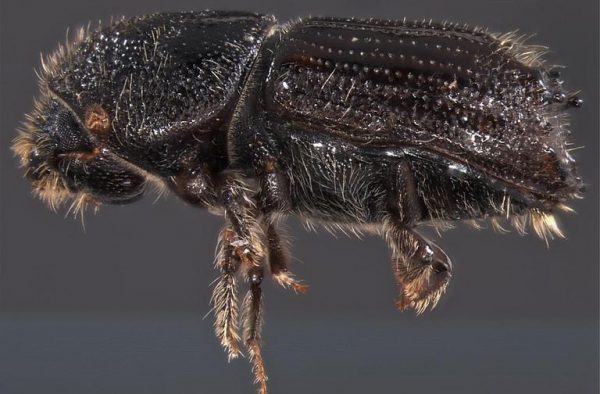
Figure 10. Note the scooped posterior and spines on this Ips pine beetle. Photo by Javier E. Mercado, Bark Beetle Genera of the U.S., USDA APHIS PPQ, Bugwood.org
BTB:
- Adult beetles are black and 6 to 10 mm in length (size of a grain of rice) (figure 9).
- BTB attack from the ground up to 8 or 10 feet high on the stem.
- Pitch tubes can range from quarter to half-dollar size (these are larger than those from Ips engraver beetles or SPB) (figure 1).
- Pitch tubes are large and pinkish white to reddish brown in color.
- Larval feeding creates fan-shaped egg galleries under the bark.
- Attacks typically occur on damaged trees or on stumps of recently cut trees and may spread to adjacent trees.
- Mortality typically is not an issue for any of the southern pines, especially if healthy.
Ips engraver beetles and SPB common identifiers:
- Beetles are reddish brown to black.
- Beetles attack along the entire trunk, often moving from the canopy toward the ground.
- Pitch tubes are small, about the size of a dime (figure 2).
- Pitch tubes are soft and pinkish white, white, or yellowish in color (depending on age).
- Reddish brown boring dust is found in bark crevices or on the ground (figure 4).
- Pin-sized holes are present. These are often exit holes on trees with prolonged infestations (figure 8).
- Mortality typically occurs 4 to 6 weeks after noticeable symptoms.
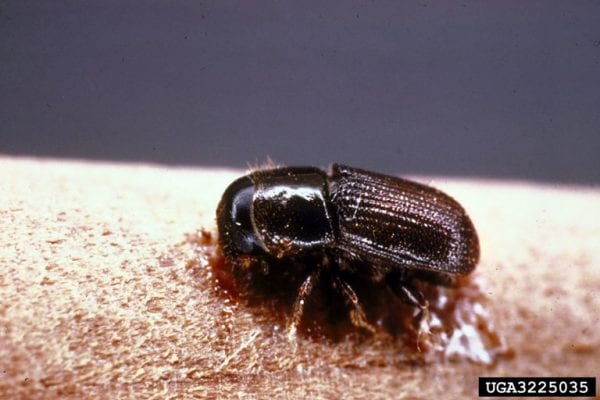
Figure 11. Note the rounded posterior on this southern pine beetle. Photo by Texas A&M AgriLife, Bugwood.org
Identifiers unique to SPB:
- Beetles are 3 mm long and have a rounded posterior (figures 9 and 11).
- Pitch tubes typically form in bark crevices (figure 3).
- When bark is removed, egg galleries have an ‘S’ or serpentine pattern (figure 6).
- Gradual foliage discoloration, from green to yellow to reddish brown, occurs.
Identifiers unique to Ips engraver beetles:
- Beetles are 2 to 6 mm in length and have a scooped posterior surrounded by four, five, or six spines depending on the species (figure 10).
- Pitch tubes typically do not form in bark crevices (figure 2).
- When bark is removed, egg galleries have a ‘Y’ or ‘H’ pattern (figure 7).
- Sudden foliar discoloration, changing from green to rusty red, occurs (figure 5).
How long have the pine bark beetles been in the tree?
It is important to determine the length of time since PBB have infested a tree(s). This will help you to choose the appropriate management option and action to take.
Change in foliar color often begins at the top of the tree and moves toward the base of the crown. Typically, the color of the foliage can be used as an indicator of how recently the infestation occurred (table 2). Some foliage, however, may slowly fade in color while others fade more rapidly depending on the type of PBB and severity of the infestation. It is worth noting that some trees may die rather quickly but not immediately show drastic changes in foliar color. It is therefore important to observe various signs and symptoms in order to evaluate the stage of infestation. Dead and vacated trees might require no action, while freshly infested trees require immediate action to limit spread.
Table 2: Identifying Stages of PBB Infestation
Modified from Mechanical Control of Southern Pine Beetle Infestations, Ronald Billings, Texas A&M Forest Service, 2011.
| Tree Stage | Symptom in Foliage | Symptom in Pitch Tubes | Symptom in Bark | Exit Holes | Ambrosia Beetle Dust |
|---|---|---|---|---|---|
| Freshly infested | Green | Soft, white, light pink | Tight, hard to remove | None | None |
| Infested with developing brood | Green fading to yellow | White, hardened | Loose, peels easily | Few | White, localized area or around the tree base |
| Vacated dead tree | Red, needles falling | Hard, yellow, crumble easily | Very loose, easily removed | Numerous | Abundant white sawdust at the base |
What are the management options for urban landscapes?
In most cases, it is too late to preserve trees once they are infested (with the possible exception of BTB). Instead, most management is recommended to prevent the spread of PBB. While PBB can fly as far as two miles, they tend to be lazy fliers. As a result, they are most likely to glide to neighboring pines. Trees standing within 20 yards of an actively infested tree are at the greatest risk.
Regularly inspect pines for indicators of infestation, especially during periods of drought or where trees are under one of the previously discussed stressors. Once the PBB are identified, use the following integrated pest management strategies.
Short-Term Management Strategies
Short-term strategies are meant for dealing with currently infested trees and preventing the spread of the pest.
- Identify the species of tree that is infested.
- Identify the type of PBB affecting your tree (BTB can be treated).
- Remove the tree immediately and grind the stump if the tree has Ips engraver beetles or SPB.
- Consider using chemical treatments on neighboring pines, especially if trees are stressed, to prevent the spread of PBB.
- Contact a professional for questions, concerns, and assistance.
Long-Term Management Strategies
- Long-term strategies are meant for ensuring the future health of the pines to reduce stressors that encourage PBB outbreaks.
- Mulch the areas around trees to help hold soil moisture, avoid soil compaction, and reduce grass maintenance damage.
- Avoid damaging the trunk or roots with lawn equipment or construction. The resinous smell associated with fresh wounds is known to attract PBB.
- Remove freshly broken limbs or snags to avoid attracting PBB.
- Avoid soil compaction by not parking inside the tree’s drip line.
What preventative chemical treatments are available?
Several chemical products and one density regulator pheromone are labeled for PBB. Each of these products has benefits and drawbacks to consider in relation to specific trees, sites, and possible impacts to nontarget species and applicators.
Contact Pesticides
Several contact pesticides are labeled for PBB prevention. These include bifenthrin, permethrin, and carbaryl. Contact pesticides will not be practical for ips or SPB in most cases as they must be sprayed on the trunk from the ground to the lower canopy.
SPB and Ips engraver beetles often start in the canopy and move downward, requiring most of the trunk to be treated. This requires the use of either a high-pressure sprayer or a bucket truck to reach the canopy of larger pines. For BTB beetle treatments, only the bottom 12 to 15 feet should be sprayed. As a result, contact pesticides work best for BTB. This method provides between 1 and 3 months of protection depending on the product and weather conditions.
If contact pesticides are used, high-risk trees should be sprayed in late winter or early spring before beetles become active. High-risk trees include trees adjacent to infested areas, trees with damaged roots above- or belowground, lightning-struck trees, over-mature trees (older trees in declining health), trees exposed to extreme drought, or trees that endure major storms such as hurricanes.
Beware. Pesticide drift, nontarget species toxicity (e.g., pollinators, aquatic species), and applicator safety are concerns when using contact pesticides. The use of a professional applicator is highly recommended. Some formulations of these chemicals are restricted use. Always carefully read and follow label recommendations when measuring and applying pesticides.
Injectable Systemic Pesticides
The injectable pesticide Emamectin Benzoate is labeled for use on PBB. While this product removes many of the challenges associated with the contact pesticides, it will require a professional arborist to macro-infuse the tree by drill into its base. The injected chemical is translocated into the tree’s vascular system and provides preventative control for up to 2 years.
Treatments should be administered during the spring prior to peak PBB activity. Injections are not recommended during periods of drought, post- infestation, or on severely stressed trees, as poor vascular conductance will result in poor product distribution in the tree. This is likely the best preventative method available due to its prolonged control, but it will come at a higher cost.
Pheromone Treatments
An alternative to pesticide use is anti-aggregate pheromones, such as Verbenone, that help to disperse adult beetles. These products only work as a preventative for SPB infestations.
SPBs produce pheromones to communicate and attract or disperse beetles. Verbenone is a synthesized anti- aggregate that is packaged in slow-release pouches, which are stapled to trees at risk from pine beetle infestation. Like pesticides, this is only a preventative treatment. Research shows that this product exhibits mixed results, and it’s generally considered to be less effective than pesticides.
The best way to prevent pine bark beetle infestations is to maintain tree health by improving resource availability (water, reducing competition, etc.) and being proactive (monitor, modify, manage). Once outbreaks occur, management is reduced to removing infested trees and possibly using preventative pesticides to protect uninfested trees. The best line of action is to maintain tree health, which is key to increasing tree resiliency to stressors and reducing their susceptibility.
 Arnold “Beau” Brodbeck, Extension Specialist; Adam Maggard, Extension Specialist, Assistant Professor; Lori Eckhardt, Professor, all with Forestry, Wildlife & Natural Resources at Auburn University
Arnold “Beau” Brodbeck, Extension Specialist; Adam Maggard, Extension Specialist, Assistant Professor; Lori Eckhardt, Professor, all with Forestry, Wildlife & Natural Resources at Auburn University
Reviewed July 2022, Managing Pine Bark Beetles in Urban Forests, FOR – 2049

